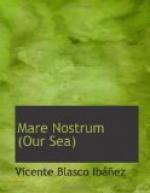Every few days ships of different class and nationality were arriving. There were those that displayed their aristocratic origin by the fine line of the prow, the slenderness of the smokestacks and the still white color of their upper decks: they were like the high-priced steeds that war had transformed into simple beasts of battle. Former mail-packets, swift racers of the waves, had descended to the humble service of transport boats. Others, black and dirty, with the pitchy plaster of hasty reparation and a consumptive smokestack on an enormous hull, plowed along, coughing smoke, spitting ashes, panting with the jangle of old iron. The flags of the Allies and those of the neutral navies waved on the different ships. Reuniting, they formed a convoy in the broad bay. There were fifteen or twenty steamers, sometimes thirty, which had to navigate together, adjusting their different speeds to a common pace. The cargo boats, merchant steamers that made only a few knots an hour, exacted a desperate slowness of the rest of the convoy.
The Mare Nostrum had to sail at half speed, making its captain very impatient with these monotonous and dangerous peregrinations, extending over weeks and weeks.
Before setting out, Ferragut, like all the other captains, would receive sealed and stamped orders. These were from the Commodore of the convoy,—the commander of a torpedo destroyer, or a simple officer of the Naval Reserve in charge of a motor trawler armed with a quickfiring gun.
The steamers would begin belching smoke and hoisting anchors without knowing whither they were going. The official document was opened only at the moment of departure. Ulysses would break the seals and examine the paper, understanding with facility its formal language, written in a common cipher. The first thing that he would look out for was the port of destination, then, the order of formation. They were to sail in single file or in a double row, according to the number of vessels. The Mare Nostrum, represented by a certain number, was to navigate between two other numbers which were those of the nearest steamers. They were to keep between them a distance of about five hundred yards; it was important that they should not come any nearer in a moment of carelessness, nor prolong the line so that they would be out of sight of the watchful guardians.
At the end, the general instructions for all the voyages were repeated with a laconic brevity that would have made other men, not accustomed to look death in the face, turn pale. In case of a submarine attack, the transports that carried guns were to come out from the line and aid the patrol of armed vessels, attacking the enemy. The others were to continue their course tranquilly, without paying any attention to the attack. If the boat in front of them or the one following was torpedoed, they were not to stop to give it aid. The torpedo boats and “chaluteros” were charged with saving the wrecked ship if it were possible. The duty of the transport was always to go forward, blind and deaf, without getting out of line, without stopping, until it had delivered at the terminal port the fortune stowed in its holds.




